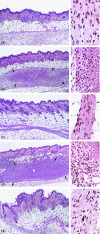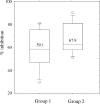Carbohydrate-based particles: a new adjuvant for allergen-specific immunotherapy
- PMID: 12460198
- PMCID: PMC1782826
- DOI: 10.1046/j.1365-2567.2002.01535.x
Carbohydrate-based particles: a new adjuvant for allergen-specific immunotherapy
Abstract
The occurrence of systemic anaphylactic side-effects in the course of allergen-specific immunotherapy has been strongly reduced by the adsorption of allergens to aluminium hydroxide, the most frequently used adjuvant in humans. Using the major timothy grass pollen allergen, Phl p 5b, in its recombinant form for immunization of mice, we demonstrate that carbohydrate-based particles (CBP) exhibit several potential advantages over aluminium-hydroxide as adjuvant for immunotherapy. Similar to alum-bound rPhl p 5b, CBP-bound rPhl p 5b induced a stronger antibody and cytokine response than unbound rPhl p 5b after subcutaneous injection in mice. The antibodies induced by CBP-bound rPhl p 5b, exhibited potentially beneficial activities as they cross-reacted with group 5 allergens from five other grass species and inhibited the binding of grass pollen allergic patients IgE to Phl p 5b. Alum-bound rPhl p 5b induced a preferential allergen-specific Th2-response characterized by high immunoglobulin G1 (IgG1) antibody levels and elevated interleukin (IL)-4 and IL-5 production in cultured splenocytes. By contrast, CBP-bound rPhl p 5b, but not rPhl p 5b alone or coadministered with CBP, induced a mixed allergen-specific T helper 1 (Th1)/Th2 immune response characterized by the additional production of allergen-specific IgG2a/b antibody responses and elevated interferon-gamma production. Conjugation of rPhl p 5b to CBP yielded a stable vaccine formulation with preserved immunogenic features of the allergen and, in contrast to alum, induced no granulomatous tissue reactions. Based on these results, CBP is suggested as a potentially useful adjuvant for specific immunotherapy of IgE-mediated allergies.
Figures





Similar articles
-
Evaluation of recombinant and native timothy pollen (rPhl p 1, 2, 5, 6, 7, 11, 12 and nPhl p 4)- specific IgG4 antibodies induced by subcutaneous immunotherapy with timothy pollen extract in allergic patients.Int Arch Allergy Immunol. 2004 Sep;135(1):44-53. doi: 10.1159/000080042. Epub 2004 Jul 30. Int Arch Allergy Immunol. 2004. PMID: 15286445
-
Allergen-specific immunotherapy with a monophosphoryl lipid A-adjuvanted vaccine: reduced seasonally boosted immunoglobulin E production and inhibition of basophil histamine release by therapy-induced blocking antibodies.Clin Exp Allergy. 2003 Sep;33(9):1198-208. doi: 10.1046/j.1365-2222.2003.01699.x. Clin Exp Allergy. 2003. PMID: 12956739 Clinical Trial.
-
Possible relationship between systemic side effects and sensitization to rPar j 2 in allergic patients submitted to an ultra-rush (20 min) sublingual immunotherapy and selected by component resolved diagnosis.Int Arch Allergy Immunol. 2005 Oct;138(2):105-10. doi: 10.1159/000088431. Epub 2005 Sep 19. Int Arch Allergy Immunol. 2005. PMID: 16174987
-
Anaphylaxis syndromes related to a new mammalian cross-reactive carbohydrate determinant.J Allergy Clin Immunol. 2009 Oct;124(4):652-7. doi: 10.1016/j.jaci.2009.08.026. J Allergy Clin Immunol. 2009. PMID: 19815111 Free PMC article. Review.
-
Novel adjuvants in allergen-specific immunotherapy: where do we stand?Front Immunol. 2024 Feb 23;15:1348305. doi: 10.3389/fimmu.2024.1348305. eCollection 2024. Front Immunol. 2024. PMID: 38464539 Free PMC article. Review.
Cited by
-
Formulations for Allergen Immunotherapy in Human and Veterinary Patients: New Candidates on the Horizon.Front Immunol. 2020 Aug 4;11:1697. doi: 10.3389/fimmu.2020.01697. eCollection 2020. Front Immunol. 2020. PMID: 32849594 Free PMC article. Review.
-
[Allergen-specific immunotherapy in pet allergy - an update].Hautarzt. 2011 Sep;62(9):657-62. doi: 10.1007/s00105-011-2159-0. Hautarzt. 2011. PMID: 21858563 Review. German.
-
Sensitive detection of antigen-specific T-cells using bead-bound antigen for in vitro re-stimulation.MethodsX. 2019 Jul 8;6:1635-1641. doi: 10.1016/j.mex.2019.07.004. eCollection 2019. MethodsX. 2019. PMID: 31367530 Free PMC article.
-
Recombinant allergens: the present and the future.Hum Vaccin Immunother. 2012 Oct;8(10):1534-43. doi: 10.4161/hv.22064. Epub 2012 Oct 1. Hum Vaccin Immunother. 2012. PMID: 23095874 Free PMC article. Review.
-
Egg Allergy: Diagnosis and Immunotherapy.Int J Mol Sci. 2020 Jul 16;21(14):5010. doi: 10.3390/ijms21145010. Int J Mol Sci. 2020. PMID: 32708567 Free PMC article. Review.
References
-
- Noon L. Prophylactic inoculation against hayfever. Lancet. 1911;1:1572.
-
- Sledge RF. Treatment of hay-fever with alum-precipitated pollen. US Naval Med Bull. 1938;36:18.
-
- Zoss AR, Koch CA, Hirose R. Alum-ragweed precipitate: preparation and clinical investigation; preliminary report. J Allergy Clin Immunol. 1939;8:29.
-
- Bousquet J, Lockey R, Malling HJ. Allergen immunotherapy: therapeutic vaccines for allergic diseases. A WHO position paper. J Allergy Clin Immunol. 1998;102:558–62. - PubMed
-
- Drachenberg KJ, Wheeler AW, Stuebner P, Horak F. A well-tolerated grass pollen-specific allergy vaccine containing a novel adjuvant, monophosphoryl lipid A, reduces allergic symptoms after only four preseasonal injections. Allergy. 2001;56:498–505. - PubMed
Publication types
MeSH terms
Substances
LinkOut - more resources
Full Text Sources
Other Literature Sources

